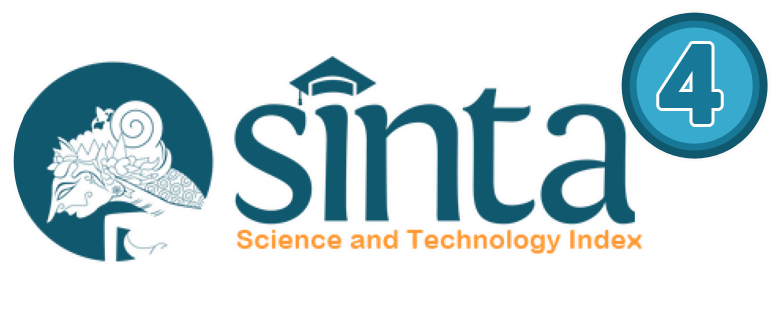Representasi Makna Denotasi dan Konotasi dalam Lirik Lagu Kun Fayakun (Analisis Semiotika Roland Barthes)
 Abstract views: 5077
,
Abstract views: 5077
,
 pdf downloads: 4251
pdf downloads: 4251
Abstract
This study aims to describe the meaning implied in the Arabic song “Kun Fayakun” lyrics through translation and study process analysis. As for this research, the author used the qualitative-descriptive method by making observations through existing data, looking for patterns between relationships with various concepts that have not been previously determined, analyzing, then providing understanding and explanations. The data were collected by observation and documentation technique and analyzed by Roland Barthes's semiotic theory. The outcome that was gained from this research is as follows: 12 the denotative and 12 connotative meaning which have an important role in helping the reader to understand the song lyrics of literary meaning and its implicit meaning.
Downloads
References
Astuti, Haristin Vindi. “Citra Perempuan Berhijab Dalam Film Bulan Terbelah Di Langit Amerika.” Skripsi (2021).
Afdhaludin, Faizal Surya. “Pesan Dakwah Habiburrahman El Shirazy Dalam Novel Bidadari Bermata Bening Karya (Analisis Semiotik Model Roland Barthes).” Skripsi (2018).
Bahasa, Badan Pengembangan dan Pembinaan. “Kamus Besar Bahasa Indonesia Daring.” https://kbbi.kemdikbud.go.id/
David Ardhy Aritonang and Yohannes Don Bosco Doho, “Analisis Semiotika Roland Barthes Terhadap Lirik Lagu Band Noah 'Puisi Adinda',” Ilmu Komunikasi dan Bisnis, Vol. 4, No. 2, 2019: 77–103. http://www.journal.starki.id/index.php/JIK/article/view/217
Devi Arie Shandy, “Representasi Makna Pesan Dakwah Dalam Lirik Lagu Tomat (Tobat Maksiat) Pada Album Ingat Shalawat Karya Wali Band,” Jurnal Online Mahasiswa (JOM) Bidang Ilmu Sosial dan Ilmu Politik, Vol. 1 No. 2, 2014: 1–15. https://jom.unri.ac.id/index.php/JOMFSIP/article/view/3010
Emil Septia, Silvia Marni, and Armet Armet, “Representasi Nilai Religi Dan Kepengarangan Puisi-Puisi Karya Taufik Ismail,” Poetika: Jurnal Ilmu Sastra, Vol. 7, No. 1, 2019: 32-50. https://jurnal.ugm.ac.id/poetika/article/view/43493
Fitri, “Analisa Semiotik Makna Motivasi Lirik Lagu ‘Cerita Tentang Gunung Dan Laut’ Karya Payung Teduh.” Jurnal Komunikasi, Vol. 8, No. 3, 2017. https://ejournal.bsi.ac.id/ejurnal/index.php/jkom/article/view/3071
John, Asril, and Agung Eko Budi Waspada, “Analisis Semiotika Logo Rumah Makan Patinku,” Proporsi, Vol. 3, No. 1, 2017: 33–43. http://e-journal.potensi-utama.ac.id/ojs/index.php/PROPORSI/article/view/551
Lilik Ummi Kaltsum, “Cobaan Hidup Dalam Al- Qur ’ An ( Studi Ayat - Ayat Fitnah Dengan Aplikasi Metode Tafsir Tematik )” Ilmu Ushuluddin, Vol. 5, No. 2, 2018: 107-138. http://journal.uinjkt.ac.id/index.php/ilmu-ushuluddin/article/view/12778
M Imron, “Semiotika Dalam Lirik Lagu Arab Kun Anta Yang Dipopulerkan Oleh Humood Alkhuder,” Skripsi (2018). https://repository.uinjkt.ac.id/dspace/handle/123456789/40585.
Muhammad bin Duhai, penyair, Wawancara, Instagram, 7 September 2021.
Niswati Khoiriyah dan Syahrul Syah Sinaga, “Pemanfaatan Pemutaran Musik Terhadap Psikologis Pasien Pada Klinik Ellena Skin Care Di Kota Surakarta,” Jurnal Seni Musik, Vol. 6, No. 2, 2017: 81–90. https://journal.unnes.ac.id/sju/index.php/jsm/article/view/20313.
Nova Dwiyanti, “Analisis Semiotik Citra Wanita Muslimah Dalam Film ‘Assalamualaikum Beijing’.” Tesis (2016): 1–111. http://repository.uinsu.ac.id/1351/
Prina Yelly, “Analisis Makhluk Superior (Naga) Dalam Legenda Danau Kembar.,” Journal Serunai Bahasa Indonesia, Vol. 16, No. 2, 2019: 123. https://ejournal.stkipbudidaya.ac.id/index.php/je/article/view/200
Putri Sion Sinaga, “Semiotika Umpama Bahasa Batak Toba: Pendekatan Roland Barthes,” Jurnal Ilmiah Korpus, Vol. 5 No. 1, 2021: 81-92. https://ejournal.unib.ac.id/index.php/korpus/article/view/12600
Rendi Patria, Abdurahman Abdurahman, Bakhtaruddin Nasution, "Interpretasi Makna Lirik Lagu-Lagu Grup Musik ERK dalam Album ERK: Kajian Semiotika", Jurnal Bahasa dan Sastra, Vol. 1, No. 2, 2013: 69-82. http://ejournal.unp.ac.id/index.php/ibs/article/view/1481
Rif’ati Fauzan, “Kandungan Lirik Lagu Insya Allah Karya Maher Zain dalam Perspektif Al-Qu'an" Skripsi (2016). http://repository.iiq.ac.id/handle/123456789/672
Rina Septiana, “MAKNA DENOTASI, KONOTASI DAN MITOS DALAM FILM KEIN WHO AM I KEIN SYSTEM IST SICHER (SUATU ANALISIS SEMIOTIK),” JURNAL ELEKTRONIK FAKULTAS SASTRA UNIVERSITAS SAM RATULANGI, Vol. 1, No. 2, 2019: 1–4. https://ejournal.unsrat.ac.id/index.php/jefs/article/view/24151
Saiful Qadar Basri, “Tari Remo (Ngremong): Sebuah Analisis Teori Semiotika Roland Barthes Tentang Makna Denotasi Dan Konotasi Dalam Tari Remo (Ngremong),” Jurnal Seni Tari Drama, Vol. 2, No. 1, 2019: 55-69. https://journal.unesa.ac.id/index.php/geter/article/view/4800
Authors who publish with this journal agree to the following terms:
a. Authors retain copyright and grant the journal right of first publication with the work simultaneously licensed under a Creative Commons Attribution License that allows others to share the work with an acknowledgement of the work's authorship and initial publication in this journal.
b. Authors are able to enter into separate, additional contractual arrangements for the non-exclusive distribution of the journal's published version of the work (e.g., post it to an institutional repository or publish it in a book), with an acknowledgement of its initial publication in this journal.
c. Authors are permitted and encouraged to post their work online (e.g., in institutional repositories or on their website) prior to and during the submission process, as it can lead to productive exchanges, as well as earlier and greater citation of published work (See The Effect of Open Access).
Alibbaa': Jurnal Pendidikan Bahasa Arab have CC-BY-SA or an equivalent license as the optimal license for the publication, distribution, use, and reuse of scholarly work.
In developing strategy and setting priorities, Alibbaa': Jurnal Pendidikan Bahasa Arab recognize that free access is better than priced access, libre access is better than free access, and libre under CC-BY-SA or the equivalent is better than libre under more restrictive open licenses. We should achieve what we can when we can. We should not delay achieving free in order to achieve libre, and we should not stop with free when we can achieve libre.

Alibbaa': Jurnal Pendidikan Bahasa Arab is licensed under a Creative Commons Attribution 4.0 International License
You are free to:
- Share — copy and redistribute the material in any medium or format
- Adapt — remix, transform, and build upon the material for any purpose, even commercially.
- The licensor cannot revoke these freedoms as long as you follow the license terms.











